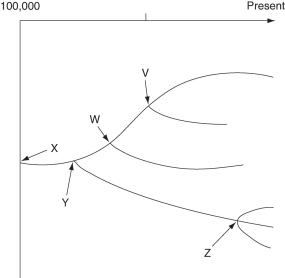Multiple Choice
The following questions refer to the evolutionary tree in Figure 22.2.
The tree's horizontal axis is a timeline that extends from 100,000 years ago to the present; the vertical axis represents nothing in particular. The labeled branch points on the tree (V-Z) represent various common ancestors. Let's say that only since 50,000 years ago has there been enough variation between the lineages depicted here to separate them into distinct species, and only the tips of the lineages on this tree represent distinct species.

-Some members of a photosynthetic plant species are genetically resistant to an herbicide, while other members of the same species are not resistant to the herbicide. Which combination of events should cause the most effective replacement of the non-herbicide-resistant strain of plants by the resistant strain?
1) The presence of the herbicide in the environment
2) The absence of the herbicide from the environment
3) The maintenance of the proper conditions for one generation
4) The maintenance of the proper conditions for many generations
A) 1 and 3
B) 1 and 4
C) 2 and 3
D) 2 and 4
Correct Answer:

Verified
Correct Answer:
Verified
Q7: The following questions refer to the evolutionary
Q10: A biologist studied a population of squirrels
Q12: Ichthyosaurs were aquatic dinosaurs. Fossils show us
Q14: The following questions refer to Figure 22.1,
Q19: The following questions refer to the evolutionary
Q20: Of the following anatomical structures, which is
Q39: The following questions refer to the evolutionary
Q46: Which of these conditions should completely prevent
Q51: Catastrophism, meaning the regular occurrence of geological
Q53: The upper forelimbs of humans and bats